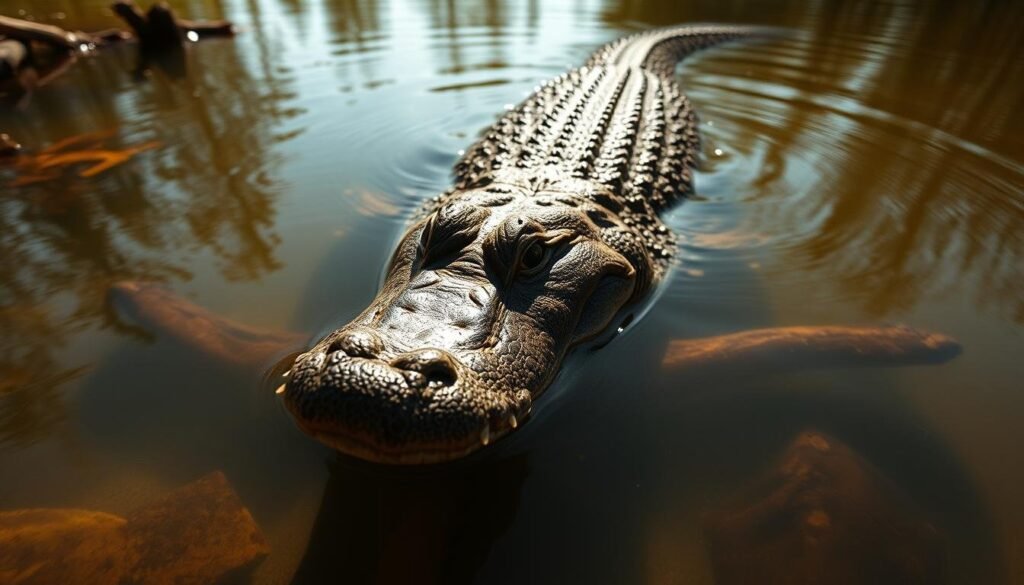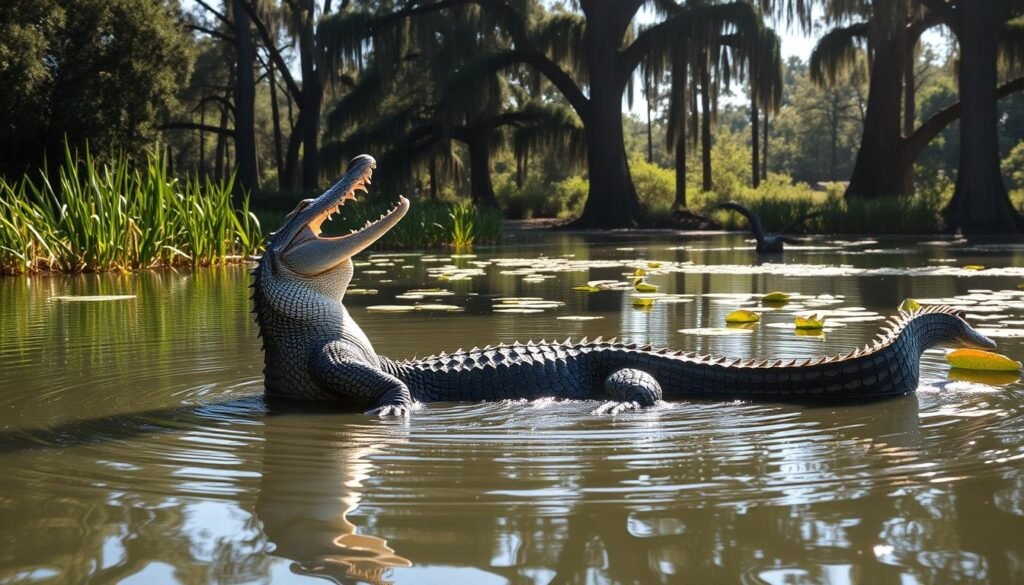Why Do Alligators Perform Mating Dances in Water? Have you ever seen alligator mating dances near a body of water? These dances are a wonder of nature. They show the beauty of water-based courtship.
Watching these alligator behavior patterns is fascinating. Their mating rituals are complex and unique. These dances are key to their reproductive cycle, happening in their water home.
Learning about these dances helps us understand alligator behavior and their water-based courtship. It shows us how amazing these creatures and their habitats are. [Why Do Alligators Perform Mating Dances in Water?]
Contents
- 1 The Fascinating World of Alligator Courtship
- 2 Why Do Alligators Perform Mating Dances in Water?
- 3 The Anatomy and Physiology Behind Water Dances
- 4 Step-by-Step Breakdown of the Alligator Mating Dance
- 5 Environmental Factors Influencing Mating Behaviors
- 6 Observing and Studying Alligator Mating Dances
- 7 Conclusion: Why Do Alligators Perform Mating Dances in Water?
- 8 FAQ
- 8.1 Why do alligators perform mating dances in water?
- 8.2 What is the role of testosterone in alligator mating behavior?
- 8.3 How do alligators use body posturing and submergence techniques during mating dances?
- 8.4 What are the regional variations in alligator mating periods?
- 8.5 How do environmental factors impact alligator mating behaviors?
- 8.6 What methods do researchers use to study alligator mating dances?
- 8.7 What is the significance of head-slapping and water dancing in alligator courtship?
- 8.8 How do special glands contribute to alligator mating behavior?
The Fascinating World of Alligator Courtship
Exploring alligator courtship reveals a complex world. Alligator courtship includes many behaviors and rituals. These are key for their mating. It’s not only interesting but also vital for understanding these animals.
Timing and Duration of Breeding Season
The breeding season for alligators happens in the spring. The exact time can change based on the environment. It lasts for several months, with males showing off to attract females.
Regional Variations in Mating Periods
Where alligators live affects when they mate. For example, in warmer places, mating starts sooner than in cooler areas.
| Region | Breeding Season | Duration |
|---|---|---|
| Florida | April – May | 3 months |
| Louisiana | May – June | 2.5 months |
Why Do Alligators Perform Mating Dances in Water?
Why do alligators do their mating dances in water? It’s because of several reasons. These reasons show how this behavior is very important for them.
Protection from Predators and Competitors
Water helps alligators stay safe from predators and rivals. It’s a safer place for them to show off their mating moves. This way, they can avoid being seen by threats.
- Reduced visibility to predators
- Less competition from other species
- A safer environment for vulnerable behaviors
Enhanced Communication in Water
Water makes it easier for alligators to talk to each other during mating. The water helps their sounds and vibrations travel far. This is key for finding a mate.
Sound Amplification Through Water
Water also makes their sounds louder. Alligators use different sounds and movements that water makes stronger. This helps them catch the attention of potential mates.
Visual Displays Enhanced by Water Surface
The water surface also makes their visual displays better. The movements create ripples and reflections. These add to the beauty of their dances, making them more appealing to mates.
Alligators use water to their advantage when mating. It shows their amazing ability to adapt and their clever strategies. [Why Do Alligators Perform Mating Dances in Water?]
The Anatomy and Physiology Behind Water Dances
To grasp the alligator’s water dance, we must look at its anatomy and physiology. This complex behavior involves many biological parts and functions. It’s a key part of their mating ritual.
Special Glands and Scent Production
Alligators have special glands for scent production. This scent is crucial for attracting mates. It signals their reproductive readiness and is released into the water.
The alligator’s body is designed for mating displays. For example, the male’s strong tail is used in the “water dance.” It also shows dominance and aggression to other males. [Why Do Alligators Perform Mating Dances in Water?]
The Role of Testosterone and Other Hormones
Hormones, especially testosterone, control the alligator’s mating behavior. During breeding season, testosterone levels rise. This triggers the growth of secondary sexual characteristics and influences courtship behavior.
Brain Regions Involved in Mating Behavior
The alligator’s brain responds to mating season stimuli. Certain brain areas are activated to control mating behaviors, like the water dance. This complex interaction between the brain and body allows for the alligator’s intricate mating ritual.
Understanding the anatomy and physiology of the alligator’s water dance shows its complexity and sophistication. It’s a fascinating look into an ancient mating ritual.
Step-by-Step Breakdown of the Alligator Mating Dance
Exploring alligators reveals their complex mating dance. This ritual is key for attracting a mate and continuing their lineage.
The dance includes deliberate movements and displays. Notably, it features head-slapping and water dancing. [Why Do Alligators Perform Mating Dances in Water?]
Head-Slapping and Water Dancing
An alligator slaps its jaws on the water’s surface, making a loud noise. This signals its presence to potential mates. The action is often paired with water dancing, where the alligator moves its body to create ripples.
Alligators also use body posturing and submergence to communicate. By adjusting their body position and diving, they signal their interest to potential mates. [Why Do Alligators Perform Mating Dances in Water?]
The alligator mating dance is a complex ritual. It combines visual and auditory displays. Understanding these behaviors deepens our appreciation for alligator courtship.
Environmental Factors Influencing Mating Behaviors
Learning about the environmental factors that affect alligator mating behaviors is key. It helps us understand their courtship rituals better. You’ll see how different environmental elements shape these behaviors.
The habitat of alligators is a big environmental factor that shapes their mating behaviors. Things like water temperature, vegetation, and nesting sites all play a part. They make their mating rituals more complex.
Climate also has a big impact on alligator mating behaviors. Changes in temperature and rain can change when and how well they mate. [Why Do Alligators Perform Mating Dances in Water?]
| Environmental Factor | Impact on Mating Behaviors |
|---|---|
| Water Temperature | Influences the timing and success of mating rituals |
| Habitat Vegetation | Provides shelter and nesting sites for alligators |
| Climate Change | Alters the patterns of mating and nesting behaviors |
As you can see, alligator mating behaviors are closely tied to their environment. Knowing these factors is crucial for conservation and managing their populations.
Observing and Studying Alligator Mating Dances
Scientists now use advanced methods to watch and study alligator mating dances. It’s key to see these dances in their natural setting. This helps us understand their behavior better.
 This research gives us insights into their social lives and what they need in their habitats. [Why Do Alligators Perform Mating Dances in Water?]
This research gives us insights into their social lives and what they need in their habitats. [Why Do Alligators Perform Mating Dances in Water?]
Watching alligator mating dances is hard because of where they live and how to not scare them. But, the knowledge we get is very important for saving their homes.
Learning about alligator mating dances helps us protect their habitats. By keeping an eye on these behaviors, researchers learn more about their lives. This knowledge is crucial for saving their homes.
Conclusion: Why Do Alligators Perform Mating Dances in Water?
You now know why alligators do mating dances in water. These dances are key to their survival. They show how alligators interact and find mates. [Why Do Alligators Perform Mating Dances in Water?]
Looking at the anatomy and physiology of these dances helps us understand their behavior. This knowledge is important for studying alligator mating.
Alligator mating dances are essential for their reproduction. We’ve seen how water is crucial for these dances. This study helps us understand alligator populations better.
Studying alligator mating dances gives us a peek into their natural world. It shows us their complex social behaviors. As we learn more, we can help protect their habitats and ensure their survival.
See Also: Why Do Sloths Move So Slowly Through Trees?
FAQ
Why do alligators perform mating dances in water?
Alligators dance in water for safety and to communicate better. It helps them make sounds louder and shows off their visual displays.
What is the role of testosterone in alligator mating behavior?
Testosterone is key in alligator mating. It helps develop their sex traits and drives them to show off during courtship.
How do alligators use body posturing and submergence techniques during mating dances?
Alligators use postures and submergence to show they’re ready to mate. It also helps them show who’s boss. [Why Do Alligators Perform Mating Dances in Water?]
What are the regional variations in alligator mating periods?
Mating times vary by region. Climate, habitat, and location all play a part, with different times for different places.
How do environmental factors impact alligator mating behaviors?
The environment greatly affects alligator mating. Things like habitat quality, climate, and water levels can make or break their courtship and breeding.
What methods do researchers use to study alligator mating dances?
Scientists observe, use camera traps, and monitor sounds to study alligator dances. It helps them understand their behavior.
What is the significance of head-slapping and water dancing in alligator courtship?
Head-slapping and dancing are vital in courtship. They send signals to mates and rivals, both visually and audibly.
How do special glands contribute to alligator mating behavior?
Special glands, like those making pheromones, are crucial. They help attract and make potential mates receptive. [Why Do Alligators Perform Mating Dances in Water?]

Zyair Larson, based in Denver, Colorado, has over 12 years of experience studying animal behavior. He has worked with the World Wildlife Fund (WWF) and National Geographic, researching wildlife and sharing insights on animal habits globally.

